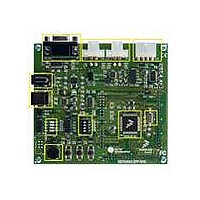DEMO9S12PFAME Freescale Semiconductor, DEMO9S12PFAME Datasheet

DEMO9S12PFAME
Specifications of DEMO9S12PFAME
Related parts for DEMO9S12PFAME
DEMO9S12PFAME Summary of contents
Page 1
... DEMO9S12PFAME Demonstration Board for Freescale MC9S12P128 (80-Pin QFP) User’s Manual Revision 1.0 Copyright © 2008 SMH Technologies DC10007 ...
Page 2
... SMH TECHNOLOGIES WILL NOT BE LIABLE FOR DAMAGES RESULTING FROM LOSS OF DATA, PROFITS, USE OF PRODUCTS, OR INCIDENTAL OR CONSEQUENTIAL DAMAGES, EVEN IF ADVISED OF THE POSSIBILITY THEREOF. Trademarks SMH Technologies is the licensee of the SofTec Microsystems trademark. Freescale™ and the Freescale logo are trademarks of Freescale Semiconductor, Inc. All other product or service names are the property of their respective owners. ...
Page 3
Contents 1 Introduction 5 1.1 Overview 5 1.2 Package Contents 5 1.3 Supported Devices 5 1.4 Recommended Reading 5 2 Hardware Features 7 2.1 Demonstration Board Features 7 3 Software Setup 9 3.1 Overview 9 3.2 Host System Requirements 9 ...
Page 4
...
Page 5
... The DEMO9S12PFAME Demonstration board has been designed for the evaluation, demonstration and the debugging of the Freescale MC9S12P128 microcontroller. The DEMO9S12PFAME can be used as a standalone application, or via its built-in USB-to- BDM bridge, or together the Freescale Student Learning Kit (Freescale code: MCUSLK) through three external 40-pin I/O female header connectors. ...
Page 6
...
Page 7
... Hardware Features 2.1 Demonstration Board Features The DEMO9S12PFAME board features: A MC9S12P128 microcontroller (in 80-Pin QFP package, already programmed with a demo application MHz crystal power supply input connector; Power input selection jumper for selecting the input voltage source input connector; o USB connector built-in USB-to-BDM circuitry which allows the host PC to communicate with the microcontroller through a standard USB interface. USB 2.0 is fully supported. When using an external in-circuit debugger (via the “ ...
Page 8
... Page 8 The DEMO9S12PFAME Demonstration Board ...
Page 9
Software Setup 3.1 Overview Note: before connecting the Demonstration Board to the PC recommended that you install all of the required software first (see below), so that the appropriate USB driver will be automatically found by ...
Page 10
... CodeWarrior installation path. 4. Click on the “Copy examples for CodeWarrior for HCS12 V.4.7” option. An Explorer window will open. Copy the “DEMO9S12PFAME” folder to your PC location of your choice. These are the examples specific for the demonstration board, and will be used later in the step-by-step tutorial. ...
Page 11
Hardware Setup 4.1 First Connection The Demonstration Board connects to a host PC through a USB port. Connection steps are listed below in the recommended flow order: 1. Install all the required system software as described in the previous ...
Page 12
Click the “Next >” button. 7. Depending on your Windows settings, the following warning may appear. Note: this warning is related to the fact that the USB driver used by i the Demonstration Board is not digitally signed by Microsoft, ...
Page 13
Click the “Finish” button to exit from the “Found New Hardware Wizard” procedure. 9. The Demonstration Board’s USB driver is now installed on your system. 4.2 Power Supply The Demonstration Board can be powered in three ways ...
Page 14
...
Page 15
Operating Modes 5.1 Overview The Demonstration Board can work in two modes: “standalone” mode and “host” mode. 5.2 Standalone Mode In standalone mode connection is required. The microcontroller is factory programmed with a sample application. To run ...
Page 16
Note: all MCUs in the S12 family contain a single-wire background debug i interface which supports in-circuit programming of on-chip non-volatile memory. This system does not interfere with normal application resources. It does not use any user memory or locations ...
Page 17
... Start CodeWarrior by selecting it in the Windows Start menu. 4. From the CodeWarrior main menu, choose “File > Open” and choose the “DEMO9S12PFAME\C\Demo\Demo.mcp” file. This is the board example you copied from the SofTec Microsystems “System Software” CD-ROM. 5. Click “Open”. The Project window will open. ...
Page 18
...
Page 19
Summary of Jumper and Connector Settings 7.1 Jumpers Name Reference J104 J202 1 RESET# BKGD J304 J305 J401 Description/Pinout VAUX ENABLE Installed: Power the demonstration board through the VDD line of the carrier ...
Page 20
Name Reference J402 ERR# STB# J502 J503 J504 J505 J506 J507 1 Page 20 Description/Pinout CAN ENABLE All Installed: The CAN transceiver is connected to the microcontroller (default) Not Installed: The CAN transceiver ...
Page 21
Name Reference J508 1 Description/Pinout LED ENABLE Installed: The LEDs are connected to PA[3..0] ports of the microcontroller (default) Not Installed: The LEDs are not connected to the microcontroller Page 21 ...
Page 22
Connectors Name Reference J101 ...
Page 23
Name Reference J102 ...
Page 24
Name Reference J103 ...
Page 25
Name Reference J105 J201 J301 J302, J303 1 J403 1 J501 2 1 Description/Pinout BDM Connector (Not Populated) 1. BKGD 2. GND 3. N.C. 4. RESET 5. N.C. 6. VDD ...
Page 26
...
Page 27
Troubleshooting 8.1 USB Driver Problems If you connected the Demonstration Board to the PC before installing the SofTec Microsystems Additional Components, the Demonstration Board’s USB driver may not have been correctly installed on your system. Unplugging and replugging the ...
Page 28
...










